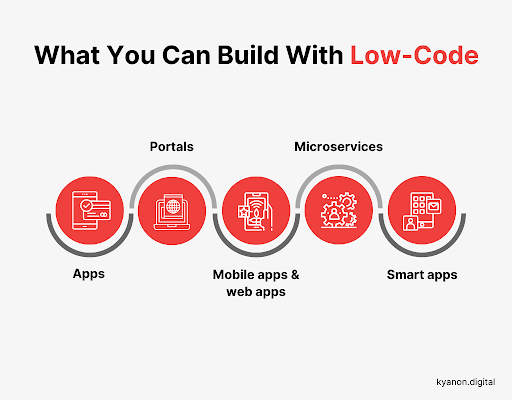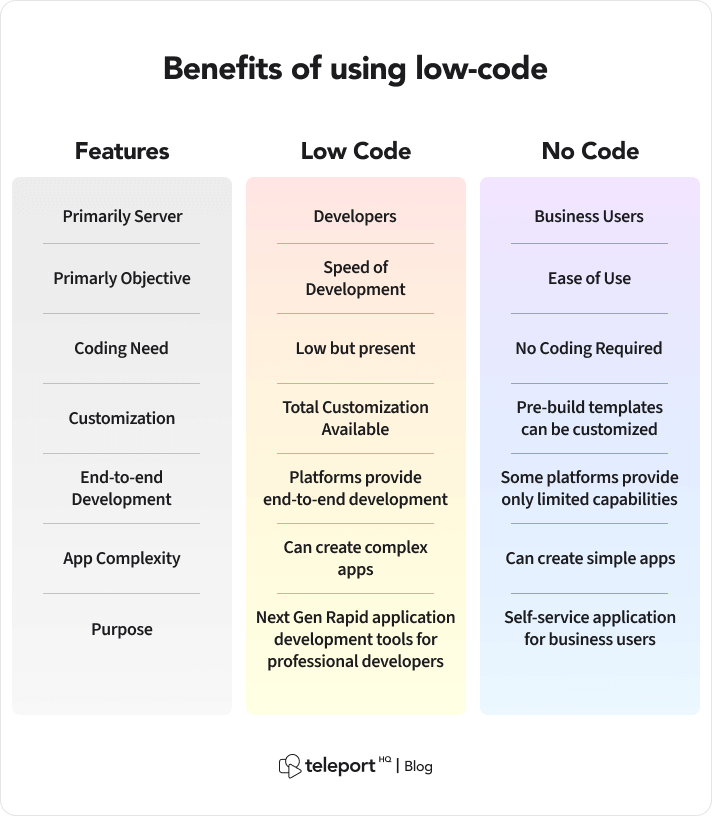Low-code applications provide significant advantages for integration, which is essential when creating applications that seamlessly connect to various systems and service. These are the main benefits: Pre-built Connectors and APIs
A Wide Variety of Connectors. Low-code systems usually include an array of pre-built connections for the enterprise system that are widely used (e.g. cloud-based services, databases and CRM). It simplifies the integration with these systems.
API Integration: Many platforms provide out-of-the-box API integration features. This lets developers quickly connect to external data and services.
Easy to utilize
Drag-and–Drop Interfaces: Many integration tasks can be easily performed using drag-and–drop interfaces. This allows for developers and others who are not developers to create complex systems without lengthy programming.
Visual Workflow builders Visual Workflow Builders: These tools can be used for designing workflows, data flow and integrations. They assist in understanding and setting up workflows more efficiently.
Standardized Integration Methods:
SOAP and Restful Service: Supporting standard web service protocols such as SOAP or REST makes it easy to integrate with external systems and applications.
OData and Other Standards: Support for standards such as OData provides easy access to and manipulation of data on a variety of platforms and applications.
Real-Time Data Synchronization:
Real-Time Integrations: Low-code platforms are capable of handling the real-time synchronization of data among systems, applications and databases. This ensures that all data is current and consistent throughout an organization.
Event-Driven Architect: Certain platforms have events-driven structures, allowing applications to respond immediately to any event. This is important for dynamic interactive applications.
Legacy System Integration:
Low-code Platforms: These platforms can be utilized to connect old systems to the latest. They're an excellent way to modernize your IT infrastructure, without having to redesign everything.
Data Migration Tools: These built-in instruments to migrate data facilitate the transfer of old systems to software developed using low-code platforms.
Third-Party Integration of Services:
Cloud Services Integration: The seamless integration of cloud services, such as AWS Azure, Google Cloud facilitates the easy deployment and scaling-up of applications.
Business Applications Integration : The low-code platform can integrate with diverse business applications, such as Salesforce.com, SAP, Microsoft Dynamics and others for seamless workflow across various aspects of business.
Simplified Data Management:
Unified data models: Certain platforms that offer low-code support for unified models of data to make data management easier across different systems.
Data Connectors are data connectors that have been pre-configured that provide rapid access to data sources and permit manipulation.
Security and compliance
Low-code platforms help ensure integrations are compliant with security protocols and standards, protecting data in transit as well as in rest.
These platforms are usually equipped with features that ensure conformity (e.g. HIPAA, GDPR) and provide peace of mind to businesses that handle sensitive data.
Extensibility:
Low-code platforms allow for the use of customized scripts and code to satisfy more complicated integration needs. This flexibility is available without compromising user-friendliness.
Plug-in Ecosystems : A system of extensions and plugins allows users to expand the possibilities of integration. They can add new features when they require.
Low-code platforms provide a powerful instrument to create interconnected efficient and scalable apps. They streamline the process of linking disparate systems. They increase data flow, and enable enterprises to use existing technologies while adopting new ones, thus ensuring the integration of a seamless IT environment. View the recommended Low-code Platform for application development recommendations for site tips including paas service, driver jdbc, mobile development platforms, sso azure, cloud software applications, cross platform mobile app development, sso azure, cross platform mobile development, paas service, develop web application and more.

Flexibility And Scalability Are Two Advantages Of Low Code Application Development
Low-code development of apps offers many advantages, including scalability and a flexible design for the application. These are essential for creating applications that can adjust to the changing demands and evolve with the company. These are the major advantages: Rapid Scaling
Cloud-Based Platforms: Many platforms for low-code are cloud-based. They allow applications to easily scale up and down with the cloud infrastructure. This lets businesses handle increased loads without worrying about server management.
Auto-Scaling Functions: Auto-scaling features are able to automatically adjust resources according to demands. They make sure that performance is consistent at peak times.
Flexible Architecture:
Modular Application Design: Low-code platform allows for modular design of application. Components can be independently developed, tested and scaled. This modularity is a great way to enhance flexibility. It can also be used to modify and expand the functionality of an application without having the whole application affected.
Microservices Integration Microservices Integration: Microservices support allows applications to be developed by combining loosely coupled services, enhancing the scalability as well as flexibility.
Customizable Solutions
Extensibility: Low-code platforms generally allow for customization of scripts and codes which allows developers to extend the functionality of applications beyond the ones that are available. This allows developers to satisfy their own business needs without restrictions.
Third-Party Integrations: The incorporation of APIs, third-party services or other types of services permits companies to enhance the functionality of their applications by incorporating additional functions.
Agile Development & Deployment
Continuous Delivery and Deployment: Low-code platform support agile methodologies which allow continuous integration, continuous delivery (CI/CD). This enables rapid deployment of updates and the introduction of new features, allowing apps to develop quickly as a result of customer feedback and changes to the market.
Iterative development: Low-code development is iterative, which means applications can be scaled and improved in a gradual manner. This minimizes the chance of major changes and allows an controlled growth.
Resource Optimization
Low-code platforms provide tools to analyze and monitor the performance of applications, which helps optimize resource usage. This ensures resources are used efficiently and are scalable according to the needs of the user.
Load-balancing: Features that distribute workloads equally across servers enhance the capacity of applications to handle large traffic and guarantee consistent performance.
Global Reach:
Multi-Region Implementation: Low code platforms can be deployed across a variety of geographical regions. This allows businesses to offer users low latency internet access across the globe. This is vital for applications that serve an international audience.
Localization Support: Built-in support for localization lets applications be easily adapted for different local languages and requirements and thereby allowing them to be more flexible in different markets.
Maintenance and Updates:
Simple maintenance: The visual and module nature of low-code software makes it easy to perform the maintenance chores. They permit updates and bugs fixes to be implemented rapidly without extensive downtime.
Version Control Systems for Controlling Versions will help you manage updates, rollbacks and other changes. They make sure that they are released safely and previous version can be restored when necessary.
Cost Efficiency:
Lower Development Costs: By cutting down on the need for extensive coding, low-code platforms lower development costs and enable to scale applications without a proportional increase in development expenditure and effort.
Pay-As You-Go Models - Many low-code platforms have flexible pricing models, such as pay-as you-go that aligns costs with actual usage, growth and financial flexibility.
Overall, the scalability and flexibility advantages of low-code applications enable businesses to build robust, adaptable and scalable apps efficiently. These platforms permit quick adaption to evolving requirements, efficient resource usage, and continual enhancement. This ensures that applications can grow with the business. Take a look at the top rated next page for Legacy application modernization with Low-code for site recommendations including develop web app, develop mobile application, software for app development, sso azure, rad application development, sso azure, stored sql procedures, driver jdbc, rad development, application modernisation and more.

Benefits Of Developing Applications Using Low-Code In Terms Of Collaboration And Workflow
It's a great option for companies looking to increase team productivity as well as streamline processes and enhance collaboration. Here are a few of the advantages.
Unified Development Environment (UDE): Low-code platforms offer one, unifying development environment that allows everyone in the team including developers as well as business analysts to collaborate effectively. This eliminates silos and enhances communication.
Visual Development Tools Low-code platforms are straightforward to use and feature a drag-and drop interface. This lets non-technical people on the team to participate in the development phase and ensures that the business requirements can be captured accurately.
Communication Enhancement
Real-Time Co-operation: Many platforms that use low-code support real-time co-operation features like commenting, editing simultaneously and instant feedback. They facilitate constant communication, reducing the amount of time required for back-and-forth discussions.
Shared Workspaces: Teams can work in shared workspaces. They are able to view edit, discuss and even discuss elements of the project. This ensures that everyone is working towards an agreed-upon goal.
Streamlined Workflow:
Integrated Project Management Tools: A lot of low-code platforms have integrated tools for managing projects that help teams monitor and plan their development projects. This includes task management, progress tracking and deadline management.
Workflow Automation Automating routine tasks or workflows permits teams to focus their efforts on more strategic initiatives and tasks, improving the efficiency overall of the organization.
Faster Iteration Cycles:
Rapid Prototyping: Platforms that use low-code allow rapid prototyping and iterative development, allowing teams to develop prototypes, test, and refine applications with shorter time. This allows feedback to be quickly incorporated, and improvements can be implemented.
Support for Agile Development: Using agile practices lets teams collaborate continuously during sprints. This makes it simpler to adapt and deliver small steps to improve functionality.
Accessibility for those who are not developers
Citizen Development: Low code platforms enable business users (citizens developers) to create and modify their applications without having a deep understanding of programming. This eases the workload on IT teams as well as developers, enabling them to respond more quickly to business needs.
Training and Onboarding – Intuitive interfaces, comprehensive training materials, and intuitive interfaces make it easy to help new members get up to speed and boost the overall team collaboration.
Centralized Knowledge Sharing and Documentation:
Integrated Documentation: Low-code systems usually include features for creating and maintaining documents within the platform and ensuring that all information about projects is centralized and easily accessible.
Knowledge Repositories : Teams are able to build knowledge repositories that contain templates, best practices, and reused components. This allows for sharing of knowledge and minimizes the need for duplicate efforts.
Consistency in Standardization
Standardized Components. The standardization of components across various applications assures uniformity, which makes it easier to work on and be understood by team members.
Governance and Compliance: Built-in frameworks for governance ensure that each development is in line with the organizational guidelines and regulations which reduces the chance of non-compliance, and ensuring that applications adhere to high-quality standards.
Feedback and Improvement:
Integrated Feedback mechanisms: Platforms with low-code typically have a built-in feedback mechanisms, which allow users to give their feedback to applications. Feedback can then become part of the development.
Continuous Improvement: The capacity to quickly iterate and then deploy changes in response to feedback allows for continuous improvement of applications. They are in close alignment with the needs of users and business objectives.
Visualization, Reporting and Analysis:
Real-Time Analyses: The built-in reports and analytics tools offer immediate insight into project's progress, performance and user interaction, allowing the use of data to make informed decisions.
Visual Workflow Mapping Visual tools that map workflows and processes can help teams optimize their workflow by identifying bottlenecks.
The advantages of developing low-code applications in terms of collaboration and workflow are in its ability to unite teams from different backgrounds as well as streamline communication and streamline processes. This results in a more cooperative and productive development environment, ultimately leading to better-performing applications and greater alignment with business objectives.
